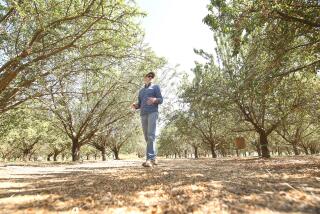Scientists Will Unleash Wasp to Slow Ash Whitefly : Infestation: Clouds of the pest are expected to return this summer. Meaningful control is years away.
That other menacing fly--the pinhead-sized ash whitefly--has returned after a wintertime reprieve to renew its ferocious attack on Southern California shade trees. This year, though, a deadly surprise might be lurking in the foliage for the bothersome pest.
While an army of state agriculture officials is engaged in a full-scale battle with the Mediterranean fruit fly, a handful of entomologists have laid plans to launch the first large-scale assault against the ash whitefly.
Later this month, they will set loose speck-sized, stingless wasps to prey on whitefly larvae. Between 25 and several hundred of the wasps will be dispersed at various Southern California locations, which scientists will closely monitor to determine how best to conduct a broader biological war later this summer.
The wasp releases will culminate a year of successful research that has identified at least one imported whitefly predator that can survive in California and eventually help control the flourishing populations, said UC Riverside scientists. Previously, it was thought that the whiteflies had no natural predators.
A noticeable reduction in whitefly populations, however, is years away. It will take that long for wasp colonies to gain a stronghold against the pest. Exasperated residents, who competed for outdoor airspace with swarming flies during the height of last summer’s infestation, can expect the same frustration this season.
“Unfortunately, we can expect to find a whole lot of whiteflies again just like last year,” said Kathy Brunetti, who oversees the state Department of Agriculture’s whitefly task force. “But with any luck we will have to live with this for only a few more years.”
Last September, infestations became so dense that afternoon breezes stirred up whitefly clouds, ruining back-yard barbecues and gatherings. Those who braved the swarms complained that they were often forced to cover their mouths to avoid inhaling the flies. Sticky dew excreted by the whitefly coated cars and was tracked inside homes, dirtying floors and carpets.
“We are already starting to see them show up,” said BJ Hegedus of North Hollywood, whose front yard is shaded by a tall ash tree. “We are bracing for the worst again. Although I can’t imagine it getting much worse than last year. I can’t help but think how many I swallowed.”
Public demand for whitefly relief is so strong that the locations of the May test releases are not being disclosed because researchers fear that homeowners will steal the wasps to combat their own infestations.
“A lot of people are calling us asking us for wasps to release in their own yard,” said Janet White, a spokeswoman for UC Riverside scientists conducting whitefly studies. “We don’t want people to know precisely where they are. We don’t want them disturbed.”
In July, a panel of county agricultural commissioners will select 12 counties to receive limited wasp supplies. James Harnett, Orange County agricultural commissioner and chairman of the whitefly committee, said the wasp will likely be released in the most heavily infested regions.
The ash whitefly, first identified in California in 1988 at a Van Nuys fruit stand, is viewed primarily as an urban nuisance by the state Department of Food and Agriculture.
The fly damages popular shade and ornamental trees, such as ash and pear, by sucking juice from the undersides of leaves, weakening and sometimes defoliating trees. It also favors apple, citrus, pomegranate and olive trees. The insect does not directly attack fruit.
In contrast, the Mediterranean fruit fly, decried by farmers and state officials as a grave threat to agriculture, is the target of an aggressive eradication campaign. The Medfly lays it eggs in a wide variety of fruit and vegetables, ruining the produce for market.
Ash whitefly infestations have become fully established throughout Los Angeles, Orange and Riverside counties. Since 1988, the fly has invaded 16 California counties from San Diego to Sacramento.
Officials suspect that the insect had been taking hold for a year or more before the outbreak was noticed, but residents with infested trees did not report the infestation because other whitefly species commonly invade yards.
Pesticide applications won’t work against the whitefly because of the infestation’s magnitude. Also, it is difficult to knock the fly down with sprays, because it lives shielded beneath leaves, entomologists said.
“This is so widespread we can’t eradicate it,” Brunetti said.
Last year scientists journeyed to Israel and Italy, where the whitefly is fully entrenched, and brought back the Encarsia wasp species. Scientists said several natural whitefly enemies will be needed to establish permanent control of the pest. A beetle imported from Israel is under study.
“We believe biological control is the most economically and biologically sound approach,” said Tim Paine, a UC Riverside entomologist.
Scientists and agricultural officials say it is impossible for homeowners to eliminate the fly on their property because within hours a neighbor’s whiteflies will infest the tree.
Paine said it would take large doses of pesticide to kill the whiteflies infesting a 40-foot-tall ash tree, and the attempt might burn leaves and further weaken the tree.
More to Read
Sign up for Essential California
The most important California stories and recommendations in your inbox every morning.
You may occasionally receive promotional content from the Los Angeles Times.










